Golden Age of Russian Nobility
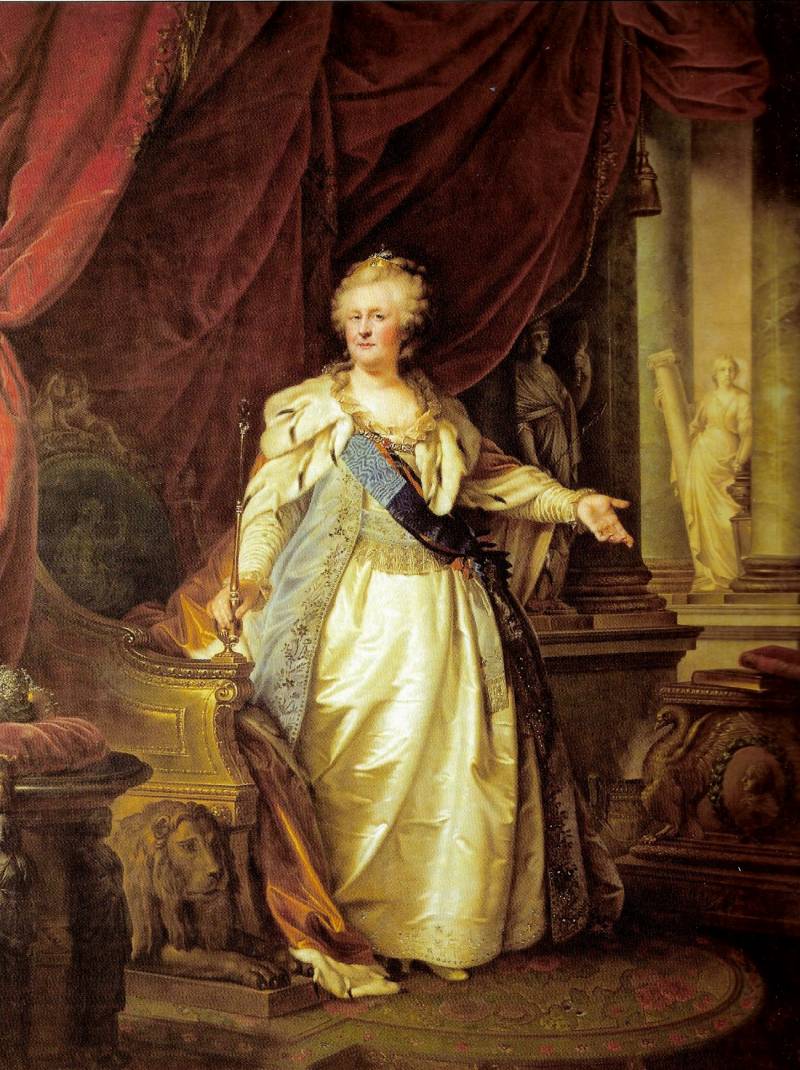
Catherine the Great in her coronation dress. Hood. V. Eriksen. XVIII century
Without understanding the basic principles of the development of society, everything will come down to particulars, the passions of individual rulers, “good” in the opinion of some, and “bad” in the opinion of others, and indicative events that can be interpreted solely based on their own preferences, to which everyone has the right, but that does not correspond to the real scientific picture of the development of society.
Noble dictatorship
Peter the Great, through modernization, protected the country and created development prospects for it. At the same time, modernization sharply strengthened the ruling class of feudal lords, removed it from the peasants and other “classes” dependent on them, and raised it high above them.
Thus, the country established the full power of the noble class with a system of governance - the monarchy. It was a feudal state, and not the “eternal Russian statehood.”
The “dictatorship of the nobles” for almost two centuries determined the political and economic structure of the state, conducting, especially in the first period, a kind of unregistered election of kings. Those who were “disqualified” by murder were: the infant John III (VI) Antonovich - although not immediately, Peter III - a few days later, and Paul I - immediately. Nicholas I looked at the Decembrist uprising as a similar revolution, a coup, of ungrateful nobles, reminiscent of the overthrow of his father Paul, and not an ideological movement.
Catherine II the Great, blood from blood, flesh from flesh with the feudal lords, as a sign of solidarity with the nobles of Kazan, who experienced the horrors of Emelyan Pugachev’s peasant war, called herself a “Kazan noblewoman.” But even they tried to “vote out” it through failed coups during the military crisis of 1776 and 1791–1792. in favor of her son Pavel Petrovich. Just as those who, not being the heirs of Peter the Great, encroached on the supreme power, such as A.D. Menshikov, Dolgorukovs, E.I. Biron and Grand Duchess Anna Leopoldovna, were also “balloted” in the XNUMXth century.
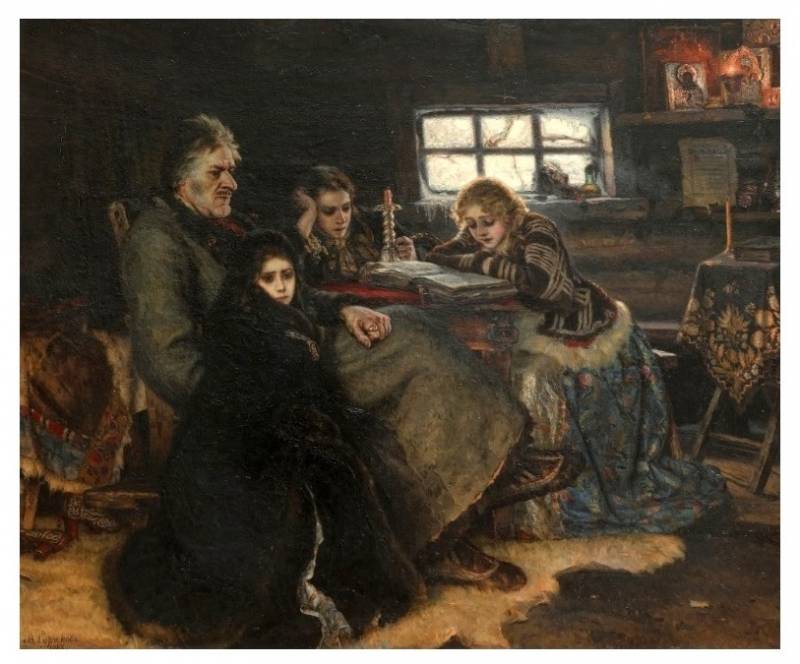
Menshikov in Berezovo. Hood. V. I. Surikov. XIX century
These noble requirements for the candidate should not be confused with the harsh conditions of serving the monarch; one did not cancel the other. The severity of the monarch Peter in relation to the nobles, with his service at the age of 25 and the beginning of service as privates, was the severity of the feudal “patrimonial” father in relation to the negligent but dear “nephews and grandchildren”, in feudal terminology, with the aim of teaching them.
The removal of one monarch or another was a struggle for a ruler who could provide the nobles with the most attractive conditions for the existence and exploitation of the dependent class, no matter what specific reasons this situation was determined by.
Management system: real and formal
Due to the fact that modernization was carried out in the country, the details of classical feudalism are not always visible in the XNUMXth century, because they simply disappeared during it: first of all, the classic feudal militia, which was the army in Europe in the XNUMXth–XNUMXth centuries, disappeared. and in Russia back in the XNUMXth century.
Indicative in this regard is the situation with the institutions of government adopted by Peter I, which, of course, were ahead of the XNUMXth century. There is absolutely no need to talk about any “regularity” or regular state, much less about a “police state”; the collective unconscious, as well as the social feudal structure, rejected it completely.
The constant and long stay of the nobles in the army during almost the entire first half of the XNUMXth century led to the spread of mass robbery in the country, but when the opportunity arose for the nobles to stay on their estates for a longer period of time, the robbery began to decline. A situation characteristic of the feudal structure of society, when it was not external government agencies, but, as before, noble city corporations, the landowners themselves, who carried out administrative and police functions locally.
And, of course, the uprising of E. Pugachev clearly demonstrated the absence of this very “police state”. The attempt to carry out “centralization” and systematization was extremely difficult in a country at a feudal stage with a feudal agrarian mentality sometimes bordering on “teenage” behavior in the service.
The management system, with its external design in the European style (Senate, collegiums) and formalistic “regularity,” retained its organic and feudal essence, and this in conditions when external threats forced the feudal state to engage in unusual issues, for example, the search for mineral resources and the creation factories. The crises of the management system that accompanied all reigns in the XNUMXth century were associated precisely with this feudal mentality.
On the other hand, it would be unfair to say that new, albeit formal, institutions did not influence society. In the end, most European states also remained feudal, albeit at later stages of development, unlike Russia. Systematic activity, which had nothing to do with the agrarian production cycle in the risky farming zone, entered Russian noble society gradually, spread from top to bottom and was associated with familiarization with European culture, literature and ideas. Of course, the school for this, first of all, was the army.
All changes associated with the creation of “supreme secret councils”, committees, cabinets and Imperial Councils, reforms of the Senate were aimed at and provided the feudal nobles with optimal conditions for managing the subordinate class – the peasants.
The development of other layers of society, such as the third estate that arose at this time, was supported and developed exclusively to achieve the main goal.
Noble legislation of the "golden age"
The government (kings, Senate, favorites, etc.) through legislation pursued a policy to strengthen the economic power of the nobles by attacking the “organic rights” of peasants and other “classes.” In 1731, a decree was adopted defining noble estates as “immovable estate-patrimonial estates,” that is, they became the full property of the feudal lords, when before that they received the estate in temporary possession for their service.
Under Elizaveta Petrovna, the Senate legislatively strengthened the economic and social positions of the feudal class. The decree of 1752, which regulated the purchase of peasants for factories, emphasized the status of serving nobles, in contrast to those who received it according to the Table of Ranks. And some decrees of the 50s and 60s. The 1762th century sought to limit the rights of manufacturers to purchase peasants. Finally, in XNUMX, a decree was introduced prohibiting the sale of peasants to factories without land.
In 1755, the nobles received the most important economic monopoly on distillation (moonshine).
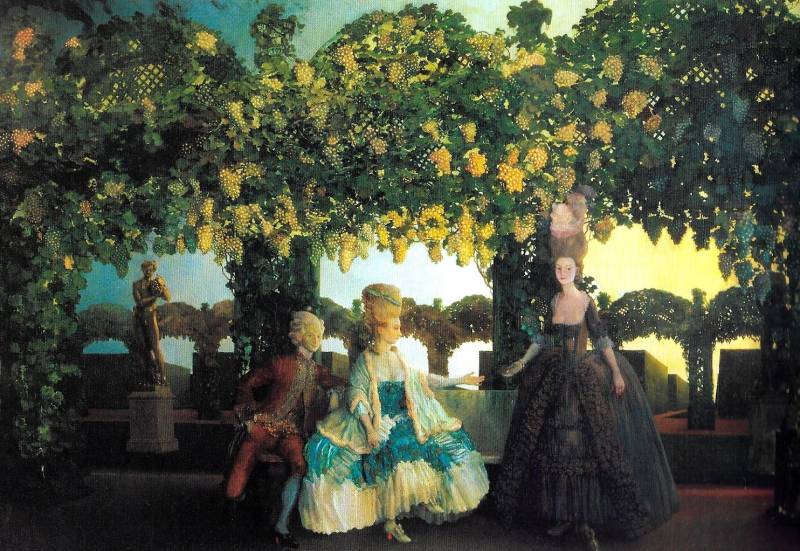
Evening. Hood. K. Somov. XX century
The decree of 1760 de jure consolidated the judicial power of the nobles over the peasants and allowed peasants to be exiled to Siberia.
In 1762, the nobles received the right to move peasants from county to county across their estates and the right to prohibit wealthy peasants from enrolling as merchants. A decree of 1767 prohibited peasants from submitting petitions to the highest name.
At the same time, “legislative projects”, which were based on examples of foreign legislation, were not successful. “Legislator” Catherine II, being under the influence of the ideas of the European Enlightenment, communicating with many of its prominent representatives, issued the highest “Order” with the aim of introducing the “spirit of law” and “fundamental laws” in Russia. Why was the Legislative Commission of 1767–1768 assembled, a kind of constituent assembly of nobles. If the philosophers J.-L. d'Alembert, D. Diderot and Voltaire supported the sincere work of the queen, then among the “main recipients” this whole undertaking failed miserably.
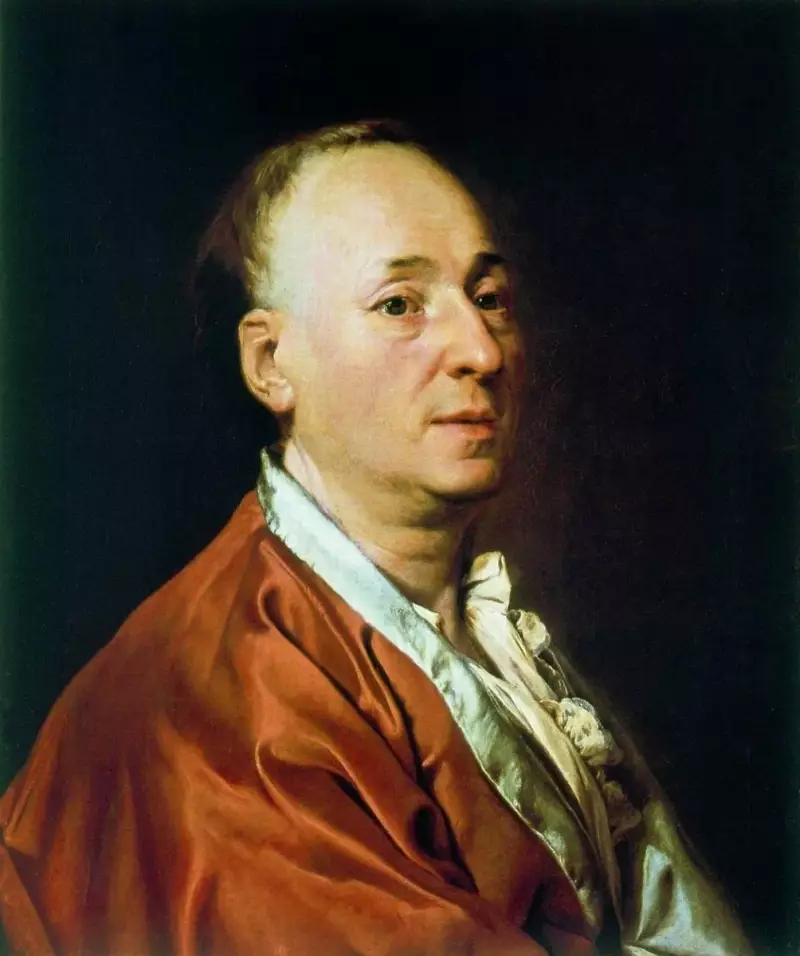
Portrait of D. Diderot. Hood. D. G. Levitsky. XVIII century
And the point is not that European foundations were alien to Russia. As we see, when it came to fashionable things, European fashion, architecture and luxury, there was no question, but the fact that these ideas had absolutely no correlation with feudal ideas and mentality; the nobles did not need abstract “civil laws”, and serf “souls”:
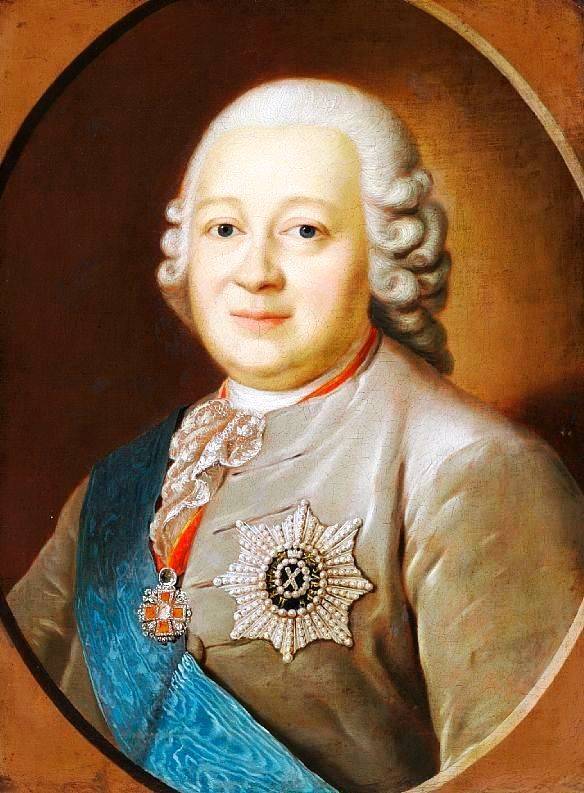
Portrait of N. I. Panin. Unknown artist. XVIII century
Another reform of Catherine II was dedicated to cities. In previous periods stories in Russian cities, as places of mass settlement, there was barter, trade, and processing of products. But they were, first of all, administrative, agricultural, fishing and trading centers, but not centers of crafts and trade, which I have emphasized more than once.
That is, there was no division of labor, and the city as a craft center did not oppose the agricultural village. In addition to some trade centers, such as Novgorod, Pskov, Arkhangelsk until the beginning of the XNUMXth century, Nizhny Novgorod, centers of crafts and processing, such as Yaroslavl, most cities were either fortresses or centers of feudal corporations, which were called “cities”, such as Smolensk or Ryazan, etc.
Perhaps only Moscow was a classical city. The classic scheme, when a posad or trade and craft suburb is formed around a seigneurial or feudal center, took shape in Russia in a good way in the XNUMXth century.
Of course, modernization has made its changes, now the city often begins to form around the plant, but the scheme remains unchanged. The rural population was 94%, while the urban population was only 6%. Therefore, the guild reform of Tsar Peter, introduced from above and borrowed from Germany, where this system developed naturally, proceeded with difficulty. By 1760 the workshops had fallen into complete decline.
It is significant that from 1700 to 1800, prices for bread (rye, oats, wheat, barley, buckwheat) increased by 350–379%, for basic agricultural products - by 500%, and for handicrafts - by 400%. And in the 61th century, with a continued increase in prices in agriculture, which by the end of the century will become average in Europe: the price of crop products will increase by 81%, livestock - by 41%, while prices for industrial goods will fall by XNUMX%. This clearly emphasizes the feudal nature of the economy in the XNUMXth century, compared to the XNUMXth century, when the growth of industrial and handicraft production, associated with the beginning of bourgeois relations, changed the direction of the movement of prices for industrial goods.
The Third Estate or the creation of the “middle class of people”
If in relation to the class of feudal lords there was a streamlining of legislation and the consolidation of their ever-increasing rights, crowned with the Charter to the nobility of 1785, then with the help of the Charter to the cities of 1785, Catherine only tried to form the urban class, the “middle class of people” or philistinism, which at this stage feudalism, like earlier in Europe of a similar period, had just emerged.
For the first time, clearly, on a legislative basis and in fact, the urban population was separated from the rural population, which led to its consolidation and received some form of self-government. It is significant that the term “estates” appeared in everyday Russian language only at the turn of the XNUMXth–XNUMXth centuries. What existed before can hardly be called “classes”; in fact, there were two classes: the fighting and the plowing. Therefore, in all previous chapters I put the word “estates” in quotation marks.
People and resources for development
The development of any social structure requires resources. For Russia in the XNUMXth century, the resource for the feudal lords, including ensuring defense, were the serfs’ “souls” or, by definition of that period, the people. And the basis of the economy of an agrarian, feudal society remained grain farming, although, for example, professional vegetable growing and gardening also appeared. In agriculture, the traditional “three-field” system was already preserved by this period, with the distribution of fields in cultivation: the first for winter crops, the second for spring crops, the third for fallow, with the presence of an even more ancient “fallow” system, when the land was left for several years without cultivation. With various variants of three-fields in Ukraine and in the steppe regions of Russia.
The maximum that could be squeezed out by a farmer under conditions of primitive, unscientific agriculture and technology, the Russian peasant squeezed out at the peak of the development of feudalism in Russia, including Ukraine, in the XNUMXth century. That is, the further development of the “golden age of the nobility” in the conditions of modernization and external threats could only occur through the constant reduction of the needs of the farmer himself. We are, of course, talking about the development of the peasant class as a whole, and not about individual, successful, “spot” representatives of it (M.V. Lomonosov, historian M.P. Pogodin or the Morozov dynasty of merchants).
The calculated minimum was 24 pounds of “bread” per adult, which provided 3 kilocalories per day. But the presence of one or two horses on the farm, and without them it would be impossible, cows and pigs reduced this diet, reducing it to 200 kilocalories. In life, the presence of only one horse on a farm led to the fact that 1% of farms were not provided with grain. An analysis of the data that we have for this period shows that there was always a shortage of bread among all peasant households: only on average 866–70%, depending on the area of residence, of families had some surplus, while the majority ( up to 9%) – a huge deficit.
Changing the yield to 1-CAM could solve the issue, but it was precisely this transition that the peasant could not achieve in the conditions of risky farming. CAM is a measure showing the return on planting, for example: from one bucket (bag, kg) the harvest will be 5-6 buckets (bags or kg), i.e. CAM-5 or CAM-6.
The average budget of a family of four at the end of the 26th century, where there were two men: father and son, that is, two revision souls, in money was 30–10 rubles. While cash income was 12–14 rubles. Which indicated a deficit of at least XNUMX rubles. That is why the book. M. M. Shcherbatov in his “Note on the Peasant Question” emphasized that hunger is a constant companion of the peasants. We are talking about the entire peasantry, the wealthy just fit within the framework of this budget.
Even taking into account the fact that during the 5th century the cost of “bread” increased 1725 times, and the poll tax remained unchanged from 1800 to XNUMX, the situation for the peasant did not change for the better. Because all meager material surpluses and working time were expropriated by the nobleman:
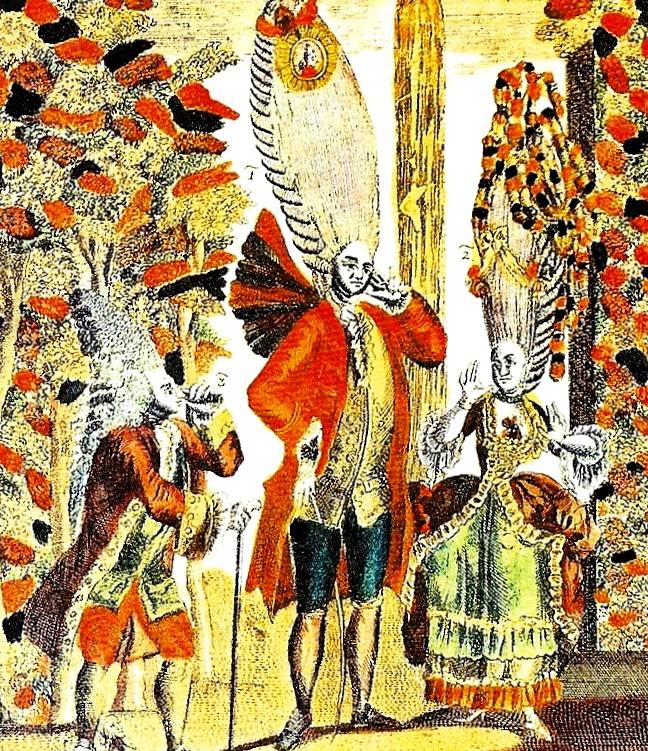
Goldfinch of the XNUMXth century. Caricature.
And this happened in a period when bread had not yet become a mass market product, which will happen in the subsequent period, where feudal rent will increase following the rise in grain prices. Which will also lead to a decrease in the consumption of kilocalories in pre-reform times, i.e. to an increase in life from hand to mouth.
The geographical and climatic environment in a harsh way, like a real “stepmother nature”, according to the apt remark of the XNUMXth century historian S. M. Solovyov, slowed down the country’s agrarian economy, but a much more important factor influencing the life of serf farmers was the ruling class of feudal lords , who confiscated (more correctly, expropriated) rent, and allowed the peasants to exist on the brink of life:
And these are not simple words. The peasants were desperately waiting for freedom, which, first of all, meant economic liberation, or, more simply, life not from hand to mouth. Rumors fueled these expectations, as was the case, for example, during the period of the Statutory Commission of 1767–1768. The forty impostors of False Peter III during the reign of Catherine II (1762–1796) reflected these aspirations. Including Pugachev, who destroyed the nobles at the root, “as a class,” and for whom the people therefore waited in the Mother See.
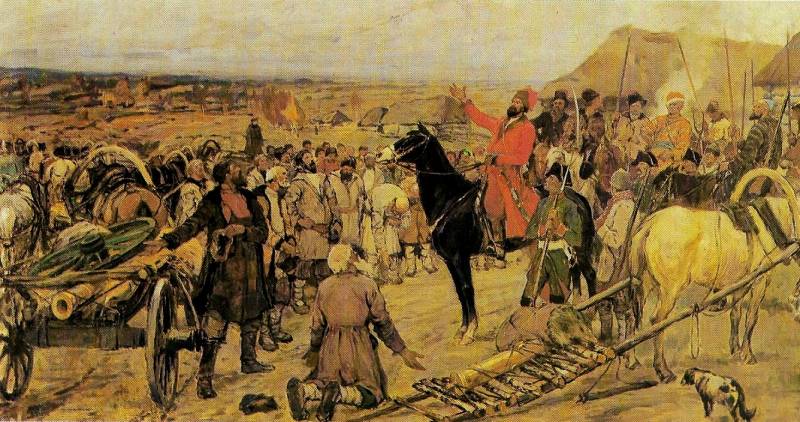
Workers bring guns to E. Pugachev. Hood. M. Avilov. 1924
It is significant that in the Penza province, where Pugachev received full support, in 1796 the grain collection per capita amounted to a huge 1 pounds (for comparison: in Kaluga there were 024, in Oryol - 256 pounds), but the population supported the leader of the uprising, because all the grain was confiscated by the nobles.
With the penetration of commodity-money relations into the country's economy from outside, bread, as the only raw material of mass production, turns into the main product, the prices of which are influenced by the international market. This situation contributed to the growth of exploitation of peasants.
The “Golden Age of the Russian nobility” in the XNUMXth century was approximately, with great reservations, identical to the period of the XNUMXth–XNUMXth centuries. in countries in Western Europe.
External pressure, which had a key influence on the peculiarities of the formation of feudalism in Russia, has been creating new challenges since the end of the XNUMXth century for it, as well as for other European countries at different stages of feudalism: the Bastille was destroyed in Paris...
To be continued ...
Information